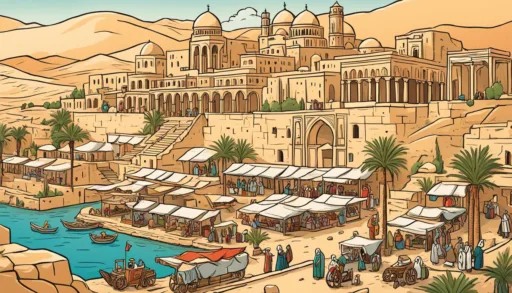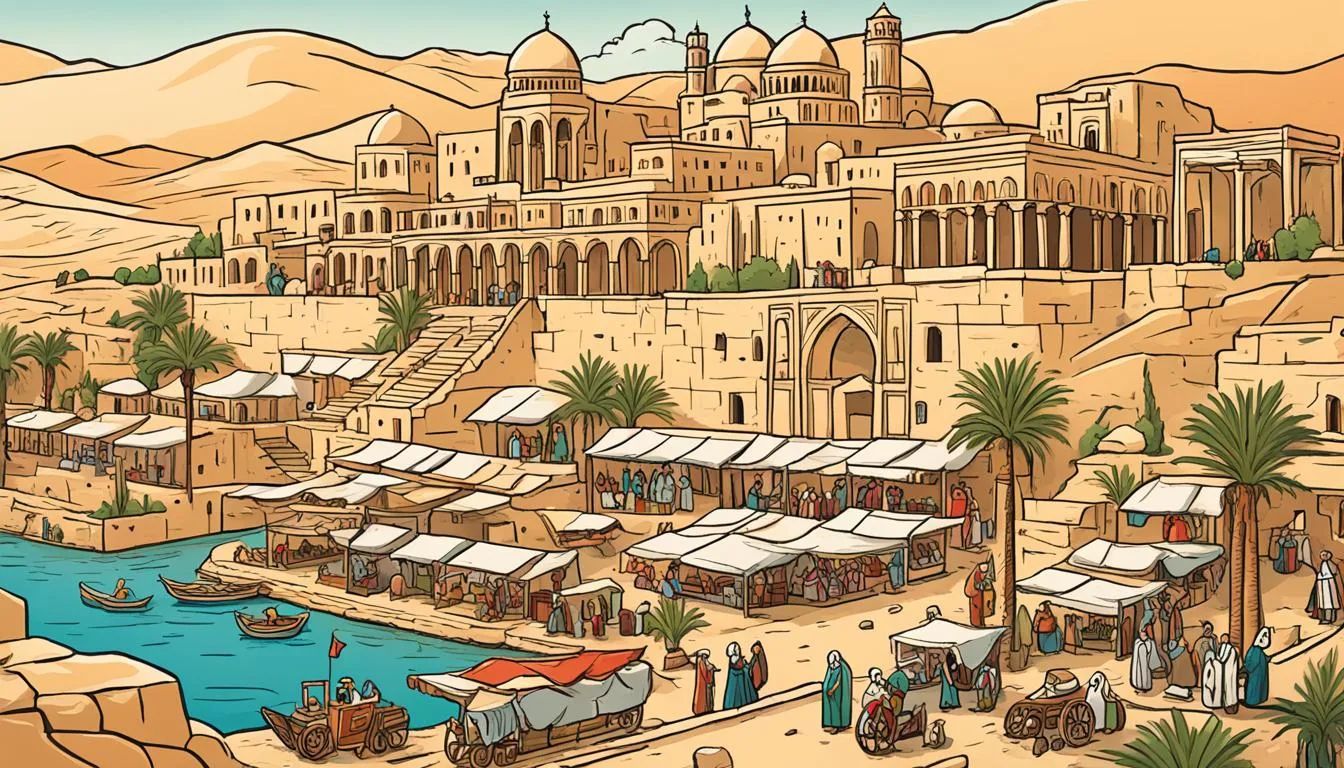Positioned at the crossroads of epochal civilizations, Syria emerges as an unparalleled destination for those enchanted by ancient history and Middle Eastern culture. But what is the best time to visit Syria? Some might argue that history, etched into stone and narrative, is impervious to the seasons. Yet, the truth is, the Syria travel season plays a pivotal role in how we experience the past.
Unlocking the door to civilizations long gone requires not just a keen eye for history but also an understanding of the ideal timing for visiting Syria. From the echo of the Assyrians’ footsteps to the whispers of Roman conquests, Syria’s landscape is a mosaic of human triumphs and tragedies. Venturing through this living museum is most rewarding when the climate conspires to comfort, rather than challenge, the curious traveler.
Key Takeaways
- Understand why timing is crucial when planning a cultural journey to Syria.
- Learn about the climate considerations that can affect your exploration of ancient sites.
- Discover the months that offer the most favorable weather for travelers in Syria.
- Find out how the seasonal nuances in Syria can enhance your historical expedition.
- Gain insight into the ways that the Syrian travel season intersects with cultural authenticity.
Exploring Syria’s Historical Timeline: A Gateway to Ancient Civilizations
The allure of embarking on a cultural journey to uncover Syria’s illustrious past is best enjoyed during the top time for a Syria trip. Traversing through the domains of ancient civilizations, one not only encounters the vestiges of yesteryear but also participates in an ongoing narrative that continues to shape the world we inhabit.
Syria’s landscape is a virtual mosaic of historical splendor where every stone tells a tale, and every pathway leads to remnants of eras gone by. It is here that travelers can witness firsthand the genesis of crucial advancements that propelled humanity into new epochs of development.
From the sturdy foundations of sedentary communities to the echelons of ancient empires, Syria’s historical landscape offers a tantalizing tapestry for anyone fascinated by the birthplaces of civilization.
Below is a table outlining some of Syria’s notable ancient highlights, which act as cornerstones for planning a trip that is as enlightening as it is memorable:
| Empire/Civilization | Distinguishing Features | Key Locations |
|---|---|---|
| Assyrians | Conquest and artistry | Tell Tamer, Mari |
| Babylonians | Code of Hammurabi; advances in astronomy | Bab al-Hawa, Tell Sabi Abyad |
| Hittites | Iron technology and cuneiform inscriptions | Yazılıkaya, Alalakh |
| Phoenicians | Seafaring prowess and spread of the alphabet | Ugarit, Amrit |
| Lydians | First coined money | Sardis, Gozlukule |
Aligning a visit during the ancient history peak season offers pristine weather and an opportunity to delve deeper into the cultural fabric of this enigmatic land. With each city and ruin telling parts of a grand narrative, your journey through Syria will become a tale worth recounting for ages.
Best Time to Visit Syria: Unveiling the Country’s Cultural Legacy
Deciding on the Syria travel season requires understanding the country’s intricate tapestry of climate, culture, and ancient history. Whether you are drawn by the allure of the ancient Middle East or the prospect of experiencing Syria’s living culture, timing your visit can significantly enhance your journey. That optimal time to travel to Syria is a window into the past and a doorway to an enriching present.

Weather Patterns and Travel Comfort in Syria
When considering the climate and travel comfort, the transitional seasons of spring and autumn are particularly enticing for their promise of gentle weather. The period from April to June, with its verdant landscapes, and September to November, offering crisp air and clear skies, bracket the ideal months for explorers and history enthusiasts alike. It is when the ancient stones of Syria’s vast heritage sites bask in comfortable temperatures, allowing for extensive on-foot exploration without the harsh extremes of summer heat or winter chills.
Annual Festivals and Cultural Events
Syria’s calendar is dotted with cultural festivities that provide a window into the nation’s soul. Festivals such as the Silk Road Festival in Damascus and the Norias of Hama Festival not only signify seasonal celebrations but are also emblematic of a storied past that continues to echo through the present. Engaging with these events offers an unparalleled opportunity to weave oneself into the fabric of Syrian life and tradition.
Maximizing Your Itinerary with Syria’s Seasonal Highlights
While mapping out an itinerary, a deeper understanding of Syria’s seasonal nuances can enrich the travel experience. The availability of fresh, local cuisine, open-air markets, and vibrant street life peaks during these congenial months, inviting travelers to fully immerse themselves into the ebbs and flows of Syrian culture. Hence, to maximize your visit, planning around these seasonal highlights is not just recommended – it’s essential.
| Month | Weather Conditions | Cultural Events | Site Accessibility |
|---|---|---|---|
| April – June | Mild temperatures, low rainfall | Jasmine Festival, Norias of Hama | Archaeological sites open and accessible |
| September – November | Clear skies, comfortable climate | Silk Road Festival, Aleppo Food Festival | Extended hours at museums and historical sites |
With such wealth in diversity, the optimal time to travel to Syria not only opens gates to ancient cities but also offers rhythmical cultural exchanges that are best enjoyed in the easing warmth of the country’s splendid seasons.
Magnificent Ruins and Cities: Syria’s Must-See Historical Sites
For those seeking the ideal timing for visiting Syria, the ancient Middle East comes alive at historical ruins which are a testament to the country’s rich civilizational tapestry. Wander through the corridors of time to view the cradle of history nestled among Syria’s most enchanting sites.
Palmyra, once a thriving city on the trade route linking Persia with the Mediterranean ports of Roman Syria, stands as a monument to human achievement and resilience. Here, one can walk among towering columns and grand temples that echo tales of bygone prosperity. The optimal time to experience Palmyra is during the spring, with its moderate climate complementing the sun-kissed stones of ancient ruins.
In the storied Aleppo, scars of recent conflicts cannot obscure the city’s historical significance. Venturing through the ancient markets and the impressive citadel offers a glimpse into the layers of history that define the region, and the cooler autumn months present an opportune moment to explore these sites comfortably.
The historic quarters of Damascus house some of the oldest continuously inhabited architecture in the world. The soul of Damascus is best discovered by walking through its narrow alleys lined with heritage that spans civilizations. Encapsulated within its walls lies a chronicle of human history waiting to be absorbed under the forgiving autumnal sun.
- Palmyra: Observe the marriage of Graeco-Roman techniques with local traditions and Persian influence within the temple walls.
- Aleppo: Witness a city rising from the ashes, demonstrating an unyielding spirit that mirrors the country’s storied past.
- Damascus: Explore a city whose ambiance channels a history rich with narratives of invention, trade, and deep-seated culture.
Syria’s panoramic canvas boasts a continuity of civilizations that is both humbling and awe-inspiring. From the relics of the Neo-Sumerian Empire to the architectural advances introduced during the Roman occupation, each stone in Syria’s monumental ruins and historic cities tells a story of humanity’s unending voyage through ages. As you plan your trip, aim for the transition months for clear skies and tranquil exploration.
From Ebla to the Ottomans: Syria’s Eras of Prosperity and Power
Traversing Syria’s historical landscape is to walk through epochs of remarkable prosperity and dominion. As each civilization imprinted its legacy, they collectively sculpted a rich tapestry that echoes through time. The best time to visit Syria is more than a matter of favorable weather; it’s an opportune moment to unravel the annals of the ancient Middle East. Explorers are rewarded with stories of cultural prosperity and historical grandeur that stand testament to the resilience and and ingenuity of humanity.
Rise and Fall of the First Eblaite Kingdom
Within the fertile crescent emerged a beacon of early civilization – the First Eblaite Kingdom. It rose to prominence through trade, diplomacy, and innovation, encompassing much of what is now northern and eastern Syria. Ebla was not just a central hub but a cradle of bureaucratic, economic, and cultural advancements that would set a precedence for future empires. The chronicles of Ebla’s ascendancy and eventual decline mirror the ephemerality of power, forming a critical chapter in Syria’s historical saga.
The Military Might of the Akkadian Empire
As the baton of civilization was passed, the Akkadian Empire forged a narrative of conquest and military prowess. This period of Syria’s history is marked by strategic dominance and the spread of the Akkadian language, establishing a linguistic unity that would influence the region for centuries. The legacy of the Akkadians is etched in stone and myth, leaving behind an era reflective of the cultural prosperity that once reigned.
The Golden Age of the Neo-Sumerian Empire
The Neo-Sumerian period, often referred to as the Ur III dynasty, heralded a golden age where art, literature, and architecture flourished as never before. This era saw the zenith of Sumerian influence – from intricate ziggurats that reached towards the heavens to cuneiform scripts that chronicled the intellectual endeavors of its people. The vibrancy of this era still captivates those who journey through Syria’s vast historical dunes.
The Strategic Position of the Mitanni Kingdom
The Mitanni Kingdom harnessed its strategic geographical position to become a pivotal player among ancient Near Eastern powers. With ties to both the East and West, the Mitanni became connoisseurs of cultural diffusion, blending influences from various traditions. This fusion is a defining characteristic of Syria’s multifaceted patrimony and gives insight into the periods of interchange and collaboration that shaped the ancient Middle East.






